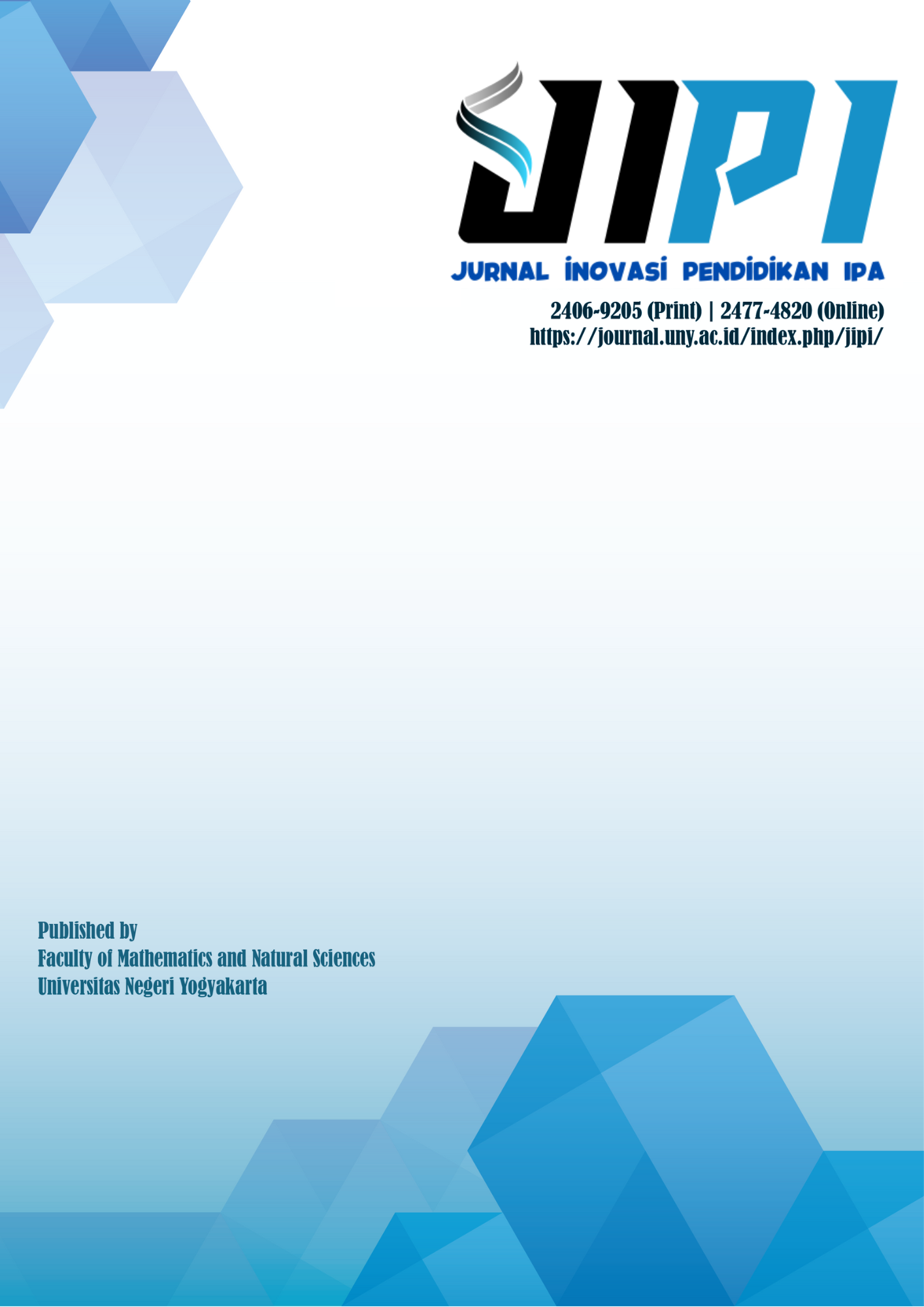Development of a quizmaker ispring approach assessment instrument to measure understanding of student concepts
DOI:
https://doi.org/10.21831/jipi.v7i2.30847Keywords:
Appraisal Instrument, Quizmaker ispring, concept understandingAbstract
The purpose of this study is to produce a valid, practical and effective Ispring Quizmaker Application Assisted Instrument. The development model of the assessment instrument used is the Plomp model which includes three stages of development, namely: preliminary research (preliminary research), the development phase or prototype (development of prototypephase), and the assessment phase (Assessment phase). The results of the study have produced a valid, practical and effective Ispring Quizmaker application-assisted assessment instrument. The instrument is valid both in terms of material, construction, media and language with an average value of 78.76% with a very valid category. The practicality of the media has an average value of 92.06% with a very practical category, while for the effectiveness of understanding physics concepts based on questions per item of indicators understanding the concept of 65, 11% with the effective category.
References
Akcay, Behiye, dan Hakan Akcay. 2015. "Effectiveness of science-technology-society (STS) instruction on student understanding of the nature of science and attitudes toward science." International Journal of Education in Mathematics, Science and Technology 3 (1): 37–45.
Al-Hakeem, Mazin S., dan Mohammad Salim Abdulrahman. 2017. "Developing a New e-Exam Platform to Enhance the University Academic Examinations: the Case of Lebanese French University." International Journal of Modern Education and Computer Science 9 (5): 9.
Alzughaibi, Mohand, Mohammed Alotaibi, Faris Ahmed, Bader Alqahtani, dan Mohammed Bargo. 2016. "PBL quizzes and their effects on student performance." Journal of US-China Medical Science 13: 108–112.
Arifin, Z. 2009. Evaluasi Pembelajaran. Bandung: PT. Remaja Rosdakarya.
Aswirna, Prima. 2018. "Penerapan Model Pembelajaran Kooperatif Tipe Talking Stick Terhadap Pemahaman Konsep Fisika Siswa di MTsN Piladang Kabupaten Lima Puluh Kota." NATURAL SCIENCE: Jurnal Penelitian Bidang IPA dan Pendidikan IPA 4 (1): 503–515.
Atia, Ahmed, Abulsalam Ashour, dan Ahmed Abired. 2018. "Frequent announced pharmacology quizzes have no impact on academic performance: An exploratory study." Ibnosina Journal of Medicine and Biomedical Sciences 10 (1): 18.
Bahar, Hasrawati, dan Pince Salempa. 2018. "PENGARUH PENGGUNAAN VIDEO PRAKTIKUM PADA PEMBELAJARAN INKUIRI TERHADAP PEMAHAMAN KONSEP DAN HASIL BELAJAR MAHASISWA STIKES MEGA REZKY MAKASSAR (STUDI PADA MATERI POKOK TITRASI ASAM BASA)." Chemistry Education Review (CER), 70–86.
Cakiroglu, Unal, Fatih Erdogdu, Mehmet Kokoc, dan Melek Atabay. 2017. "Students' Preferences in Online Assessment Process: Influences on Academic Performances." Turkish Online Journal of Distance Education 18 (1): 132–142.
Chodijah, Siti, Ahmad Fauzi, dan Ratnawulan Ratnawulan. 2012. "Pengembangan Perangkat Pembelajaran Fisika Menggunakan Model Guided Inquiryyang Dilengkapi Penilaian Portofolio pada Materi Gerak Melingkar." Jurnal Penelitian Pembelajaran Fisika 1 (1).
Eades, Vivienne, dan Monna Rizvi. 2016. "Reflections on Using ISpring Quizzes for Information Literacy Training at Middlesex University." ALISS Quarterly 11 (Januari): 6–8.
Elshafey, Mohamed A. 2018. "IRJET-Web-Based System for Creation and Management of Multiple Choices Based Quizzes and Questionnaires | Graphical User Interfaces | Test (Assessment)." Scribd 5. https://www.scribd.com/document/397019127/IRJET-Web-Based-System-for-Creation-and-Management-of-Multiple-Choices-based-Quizzes-and-Questionnaires.
Firmansyah, Aditya, Dini Hadiarti, dan Rody Putra Sartika. 2016. "Pengembangan Instrumen Penilaian (Assesment) Menggunakan Wondershare Quiz Creator pada Materi Konsep Mol Siswa Kelas X SMK Negeriv 7 Pontianak." AR-RAZI Jurnal Ilmiah 4 (2).
Herimanto, Herimanto, Eka Murdani, dan Yudi Kurniawan. 2018. "Penerapan Model Pembelajaran Inkuiri Terbimbing Untuk Meningkatkan Pemahaman Konsep Siswa Kelas VII Pada Materi Pengukuran." JIPF (Jurnal Ilmu Pendidikan Fisika) 3 (2): 44–46.
Herpiana, Ria, dan Undang Rosidin. 2019. "Development of Instruments to Train Critical and Creative Thinking Skills in Physics Assessment for High School Students' Learning." Dalam Journal of Physics: Conference Series, 1155:012046. IOP Publishing.
Husin, Abu Hassan, Abdul Manan Hairan, dan Nazlinda Abdullah. 2019. "Conceptual Understanding of Newtonian Mechanics among Afghan Students." European Journal of Physics Education 10 (1): 1–12. https://doi.org/10.20308/ejpe.v10i1.213.
Istiyono, Edi, dan Subroto Subroto. 2017. "Pengembangan instrumen asesmen pengetahuan fisika berbasis komputer untuk meningkatkan kesiapan peserta didik dalam menghadapi ujian nasional berbasis komputer." Jurnal Pendidikan Matematika Dan Sains 5 (1): 123085.
Kusumadjati, Adhi, Yetti Supriyati, dan A. Handjoko Permana. 2015. "Pengembangan INnstrumen Penilaian Pembelajaran Fisika Berbasis Animasi Flash Pada Materi Dinamika Rotasi Di SMA." Dalam Proiding Seminar Nasional Fisika (E-JOURNAL), 4:SNF2015–III.
Liew, Sang Sang, Hooi Lian Lim, Salmiza Saleh, dan Saw Lan Ong. 2019. "Development of Scoring Rubrics to Assess Physics Practical Skills." EURASIA Journal of Mathematics, Science and Technology Education 15: 4.
Malik, Abdul, Undang Rosidin, dan Chandra Ertikanto. 2018. "Pengembangan Instrumen Asesmen HOTS FISIKA SMA Menggunkan Model Inkuiri Terbimbing." Jurnal Lentera Pendidikan Pusat Penelitian LPPM UM METRO 3 (1): 11–25.
Mansour, Nasser, Rupert Wegerif, Nigel Skinner, Keith Postlethwaite, dan Lindsay Hetherington. 2016. "Investigating and promoting trainee science teachers' conceptual change of the nature of science with digital dialogue games "˜InterLoc.'" Research in Science Education 46 (5): 667–684.
McInnes, Richard. 2019. "Developing Multimedia Collaboratively: Practical Approaches for Large-Scale Online Curriculum Development" 16 (1): 14.
Mills, Susan. 2016. "Conceptual understanding: A concept analysis." The Qualitative Report 21 (3): 546–557.
Murtono, dan Evi Miskiyah. 2014. "Pengembangan instrumen evaluasi dengan teknik simulasi sebagai asesmen alternatif dalam pembelajaran fisika materi mekanika fluida sma kelas xi." Jurnal inovasi dan pembelajaran fisika 1 (1): 1–11.
Natalina, Mariani, Evi Suryawati, dan Siti Rukmana. 2015. "Pengembangan Perangkat Penilaian Berbasis Kelas pada Mata Pelajaran Biologi SMA Kelas XI." Jurnal Biogenesis Vol 11 (2): 111–118.
Odinokaya, Maria, dan Anna Zhigadlo. 2018. "Ispring suite as a new tool of e-learning." Dalam Ðаука. ИнформатизациÑ. Технологии. Образование, 1:152–157.
Palloan, P., dan A. Swandi. 2019. "Development of learning instrument of active learning strategy integrated with computer simulation in physics teaching and learning on makassar state university." Dalam Journal of Physics: Conference Series, 1157:032016. IOP Publishing.
Park, Mihwa. 2020. "Students' problem-solving strategies in qualitative physics questions in a simulation-based formative assessment." Disciplinary and Interdisciplinary Science Education Research 2 (1): 1.
Phanphech, Parinda, Tanes Tanitteerapan, dan Elizabeth Murphy. 2019. "Explaining and enacting for conceptual understanding in secondary school physics." Issues in Educational Research 29 (1): 180–204.
Potvin, Patrice, í‰rik Sauriol, dan Martin Riopel. 2015. "Experimental evidence of the superiority of the prevalence model of conceptual change over the classical models and repetition." Journal of Research in Science Teaching 52 (8): 1082–1108.
Radjibu, PIVD, dan H. Kuswanto. 2020. "Analysis of critical thinking skills and scientific communication of students for SHM concepts assisted by Ispring quiz maker test instrument." Dalam Journal of Physics: Conference Series, 1440:012054. IOP Publishing.
Rahmadani, Nudiya, Syahrul Ramadhan, dan Amalina Amalina. 2019. "Penerapan Model Trait Treatment Interaction Berbantuan Aplikasi Ispring Suite untuk Mempengaruhi Literasi Sains di SMAN 16 Padang." NATURAL SCIENCE: Jurnal Penelitian Bidang IPA dan Pendidikan IPA 5 (2): 861–875.
Rittle-Johnson, Bethany, Robert S. Siegler, dan Martha Wagner Alibali. 2001. "Developing conceptual understanding and procedural skill in mathematics: An iterative process." Journal of educational psychology 93 (2): 346.
Rusanova, L. I., dan L. S. Sazanova. 2019. "Multimedia tools of teaching foreign languages in non-linguistic schools of higher learning."
Sasahan, Elfira Yulia, Raden Oktova, dan Oky Oktavia IRN. 2017. "Pengembangan media pembelajaran interaktif tentang optika berbasis android menggunakan perangkat lunak Ispring Suite 7.0 untuk mahasiswa S-1 Pendidikan Fisika pada pokok bahasan interferensi cahaya." Dalam Prosiding SNFA (Seminar Nasional Fisika dan Aplikasinya), 2:52–61.
Spector, J. Michael, Dirk Ifenthaler, Demetrios Sampson, Joy Lan Yang, Evode Mukama, Amali Warusavitarana, Kulari Lokuge Dona, Koos Eichhorn, Andrew Fluck, dan Ronghuai Huang. 2016. "Technology enhanced formative assessment for 21st century learning" 19 (3): 58–71.
Stoen, Siera M., Mark A. McDaniel, Regina F. Frey, K. Mairin Hynes, dan Michael J. Cahill. 2020. "Force Concept Inventory: More than just conceptual understanding." Physical Review Physics Education Research 16 (1): 010105.
Struyven, Katrien, Filip Dochy, dan Steven Janssens. 2005. "Students' perceptions about evaluation and assessment in higher education: A review." Assessment & Evaluation in Higher Education 30 (4): 325–341.
Sugiyono. 2011. Metode Penelitian Pendidikan Pendekatan Kuantitatif, Kualitatif, dan R&D. 12 ed. Alfabeta, Bandung.
Sukardi. 2003. Metodologi Penelitian Pendidikan Kompetensi dan Praktiknya. 14 ed.
Taber, Keith S. 2018. "The use of Cronbach's alpha when developing and reporting research instruments in science education." Research in Science Education 48 (6): 1273–1296.
Taherdoost, Hamed. 2016. "Validity and reliability of the research instrument; how to test the validation of a questionnaire/survey in a research." How to Test the Validation of a Questionnaire/Survey in a Research (August 10, 2016) 5 (3): 26–36.
Tempelaar, Dirk, Bart Rienties, Jenna Mittelmeier, dan Quan Nguyen. 2018. "Student Profiling in a Dispositional Learning Analytics Application Using Formative Assessment." Computers in Human Behavior 78 (Januari): 408–20. https://doi.org/10.1016/j.chb.2017.08.010.
Weintrop, David, dan Uri Wilensky. 2015. "Using Commutative Assessments to Compare Conceptual Understanding in Blocks-based and Text-based Programs." Dalam ICER, 15:101–110.
Yusuf, M. 2015. Asesmen dan Evaluasi Pendidikan. Pernadamedia group.
Zakaria, Zakaria, Dini Hadiarti, dan Raudhatul Fadhilah. 2017a. "Pengembangan Instrumen Evaluasi Berbasis CBT dengan Software iSpring QuizMaker pada Materi Kesetimbangan Kimia." Jurnal Pendidikan Matematika dan Sains 5 (2): 178–183.
"”"”"”. 2017b. "Pengembangan Instrumen Evaluasi Berbasis CBT dengan Software iSpring QuizMaker pada Materi Kesetimbangan Kimia." Jurnal Pendidikan Matematika dan Sains 5 (2): 178–183.
Downloads
Published
How to Cite
Issue
Section
Citation Check
License
The authors submitting a manuscript to this journal agree that, if accepted for publication, copyright publishing of the submission shall be assigned to Jurnal Inovasi Pendidikan IPA (JIPI). However, even though the journal asks for a copyright transfer, the authors retain (or are granted back) significant scholarly rights.
Jurnal Inovasi Pendidikan IPA by http://journal.uny.ac.id/index.php/jipi/index is licensed under a Creative Commons Attribution-ShareAlike 4.0 International License.










